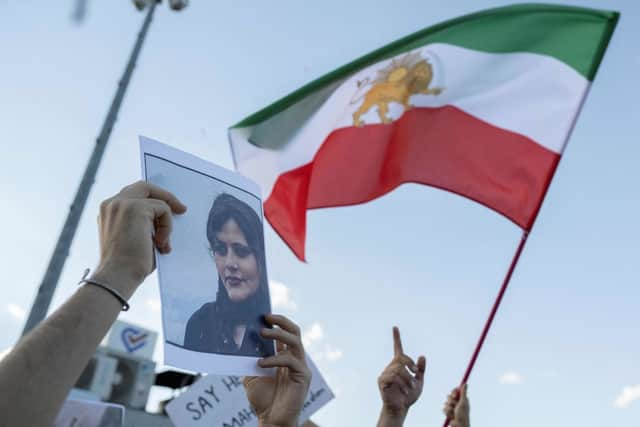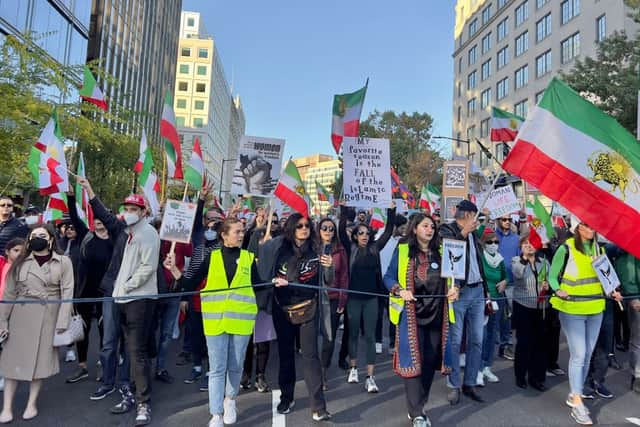Iran: have protesters been sentenced to death? Tehran court response to unrest over Mahsa Amini’s death
and live on Freeview channel 276
A court in Iran has sentenced five protesters to death as unrest continues to grip the country.
The individuals, who have not been named, have been found guilty of “enmity against God”. It is the latest development in the nationwide protests against Iran’s brutal regime and authoritarian ‘morality police’, which first started when 22-year-old Mahsa Amini tragically died in custody after being detained for allegedly breaking hijab rules.
Advertisement
Hide AdAdvertisement
Hide AdAccording to the Revolutionary Courts in Tehran, one of the protesters set fire to a government facility. Meanwhile, one allegedly hit and killed a policeman with his car, another tried to block traffic and spread “terror”, and two were conviced of knife attacks. But human rights activists have condemned the sentences, saying they were the results of unfair trials.
Concerns have since been raised that these death sentences in Tehran - which have come in quick succession - will spark a chain of “hasty executions”, with non-profit organisation Iran Human Rights warning that at least 20 people are currently facing charges considered punishable by death. Reports also suggest that 344 protesters, including 52 children, have already been killed during the protests, as security forces violently crackdown on unrest. The true number is likely higher.
There has however been the spread of some misinformation - namely, a report that claimed 15,000 protesters have been sentenced to death. Despite being untrue, this claim was widely circulated on social media and was shared by various celebrities and even Canadian President Justin Trudeau. But the fact that this report is untrue does not mean things will not get worse - with activists warning that these death sentences will continue.
Here’s exactly what is happening in the protests in Iran.


Have thousands of protesters been sentenced to death?
A claim that courts in Iran plan to execute 15,000 people recently went viral on social media, with public figures such as Sophie Turner, Viola Davis and Justin Trudeau sharing a post which reported the news on their accounts. The claim has since been proven false.
Advertisement
Hide AdAdvertisement
Hide AdTrudeau wrote on Twitter: “Canada denounces the Iranian regime’s barbaric decision to impose the death penalty on nearly 15,000 protestors. These brave Iranians were fighting for their human rights — and we continue to stand united in support of them, and united against the regime’s heinous actions.” He deleted the tweet 11 hours later, with his office commenting: “The post was informed by initial reporting that was incomplete and lacked necessary context. Because of that, it has since been deleted.”
However, the report not being true of course does not take away from the tragic fact that five protesters have indeed been sentenced to death - something activists and reporters have highlighted.
BBC World journalist Shayan Sardarizadeh said: “The widely shared claim that the Iranian regime has committed to executing 15,000 detained protesters is not true. Please stop sharing it. The Iranian regime is horrific, brutal and ruthless as it actually is. There’s no need to make up stories.”
He continued by saying it was understandable why many believed the news - because the regime in Iran, which he called “one of the most brutal on the planet,” is “not alien to mass executions”. Mr Sardarizadeh cited the execution of between 2,500 and 30,000 political prisoners which took place in 1988 as an example.
Advertisement
Hide AdAdvertisement
Hide AdBut, he explained, “it’s much harder for the Iranian regime to do mass executions in 2022 for a variety of reasons. The regime has already killed hundreds and detained thousands of protesters in just eight weeks. Report the facts of what it’s doing to Iranians. They’re horrific enough.”
His comments were echoed by another senior reporter, Siavash Adarlan, who works for BBC Persian. He first criticised Trudeau for having “weak news sources”, but also emphatically stated that the misinformation could have the “terrible result that the execution of less than 15,000 people will be considered a success by the government.”


Could a mass execution take place?
Although the above claim is not true, there is still valid concern that more death sentences will follow in the coming days, weeks and months. A Kurdish human rights group, Hengaw Organisation for Human Rights, told various news organisations: “All the detainees who were arrested during the protests are in danger of being sentenced to death by the Iranian judicial system.”
The group added that the “fate and whereabouts of most of the detainees” remains unknown, and said their fears have been reinforced by an apparent letter released by 227 Iranian Parliament members last week which called on the judiciary to carry out death sentences. Since then, a number of parliamentarians have claimed they did not support the statement and the letter was fake - although some members of the public and social media users remain unconvinced.
Advertisement
Hide AdAdvertisement
Hide AdElika Ashoori, a British Iranian living in London, told NationalWorld that she thinks the death sentences will continue “for as long as they are able to.” She said: “You are looking at a nation that is killing children, women and unarmed civilians. This doesn’t come as a shock to me, unfortunately. It is a scare tactic that has worked before, in the 1980s, and it is one they will use again until there is some form of outside intervention.”
She also said that the judge who is giving out the sentences is not allowed to practise anywhere outside of Iran “because of the crimes against humanity he has committed.” It is the same judge who sentenced Elika’s father Anoosheh Ashoori, who was imprisoned in Tehran on bogus spying charges until earlier in the year. He was released alongside Nazanin Zaghari-Ratcliffe.


As it stands, according to the Human Rights Activists News Agency (HRNA) based in the US, 15,8000 protesters have been detained following the protests. Meanwhile, Iran Human Rights, an organisation based in Norway, have said there are multiple people in this group who have committed acts which the Iranian regime will deem punishable by death.
HRNA’s director, Mahmood Amiry-Moghaddam, consequently called on the international community to take urgent action and "strongly warn the Islamic Republic of the consequences of executing protesters".
Why are there protests in Iran?
Advertisement
Hide AdAdvertisement
Hide AdThe unrest was first sparked in Iran months ago, after the death of 22-year-old Mahsa Amini. She was detained by police on 13 September for allegedly violating Iran’s strictly enforced dress code - and died three days later whilst still in police custody. The Iranian government said she died from a “sudden heart attack”, but Ms Amini’s family have cast doubt over this and suggested she was killed.
Her death came to highlight for many Iranians, particularly the young, the Islamic Republic’s heavy-handed policing of any form of defiance, as well as the increasingly brutal treatment of young women at the hands of the morality police. Protests subsequently erupted across the country.
However, Iran’s political leaders have tried to portray the protests as “riots”, with judiciary chief Gholamhossein Mohseni Ejei declaring that “rioters” could be charged with “moharebeh” (enmity against God), “efsad fil-arz” (corruption on Earth) and “baghy” (armed rebellion) - all of which can carry the death penalty in Iran’s Sharia-based legal system.
This means then that protesters taking to the streets have been met by Iran’s morality police, who have been vehemently cracking down on unrest. Thousands have been arrested, and human rights organisations are saying hundreds have likely died. On 4 October, 16-year old Nika Shakrami was added to the death toll. She was buried on what would have been her 17th birthday.


How has the world responded?
Advertisement
Hide AdAdvertisement
Hide AdProtests have taken place across the world in solidarity with those in Iran, while many world leaders have also publicly condemned the violence and imposed sanctions on the country’s government.
The UK has targeted Communications Minister Issa Zarepour, cyber police chief Vahid Mohammad Naser Majid, and a number of LEF and IRGC officials, with Foreign Secretary James Cleverly stating: "Together with our partners, we have sent a clear message to the Iranian regime - the violent crackdown on protests must stop and freedom of expression must be respected.”
The European Union has imposed sanctions on 29 Iranians and three entities it said were “responsible for the suppression of the Iranian protesters.”


Meanwhile, a movement on social media called #HairForFreedom has also been started. Activists have been cutting their hair in solidarity with Iranian women and girls, as in Iran, hair is a sign of beauty that is decreed to be hidden or covered by the Islamic Republic. Therefore, cutting it is a poignant sign of protest.
Advertisement
Hide AdAdvertisement
Hide AdA group of 50 high-profile French actresses joined the movement, in addwell as Swedish MEP Abir Al-Sahlani, who cut her hair in the European Parliament in Strasbourg. She addressed her fellow MEPs by declaring: “Until Iran is free, our fury will be bigger than the oppressors. Until the women of Iran are free, we are going to stand with you.”
Comment Guidelines
National World encourages reader discussion on our stories. User feedback, insights and back-and-forth exchanges add a rich layer of context to reporting. Please review our Community Guidelines before commenting.
